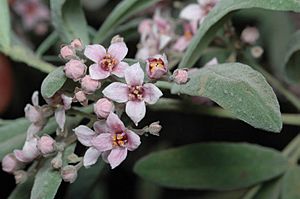Shapely zieria facts for kids
Quick facts for kids Shapely zieria |
|
|---|---|
 |
|
| Conservation status | |
| Scientific classification | |
| Genus: |
Zieria
|
| Species: |
formosa
|
The shapely zieria (scientific name: Zieria formosa) is a special plant that belongs to the citrus family, called Rutaceae. It's a type of shrub that grows only in a small area on the south coast of New South Wales, Australia. This means it's endemic there, found nowhere else in the world!
This plant is a bushy, rounded shrub with soft, velvety leaves that look a bit like clover. Each leaf is made up of three smaller parts called leaflets. In springtime, you can see groups of small, light pink flowers with four petals growing near the ends of its branches. The shapely zieria looks a lot like another plant called the Box Range zieria, but its leaflets are wider, and its flower parts have a small extra piece.
Contents
What Does the Shapely Zieria Look Like?
The shapely zieria is a thick, rounded shrub that usually grows to be about 1.5 meters (5 feet) tall and 1 meter (3 feet) wide. Its younger branches feel bumpy and are covered with tiny, branched hairs.
- Leaves: The leaves grow in pairs opposite each other on the stem. Each leaf has three small leaflets. The middle leaflet is about 15 to 30 millimeters (0.6 to 1.2 inches) long and 3 to 5 millimeters (0.1 to 0.2 inches) wide. The leaves look silvery because they are covered in many soft, velvety hairs.
- Flowers: Groups of 25 to 45 pale pink flowers grow where the leaves meet the stem. Each flower is about 6 to 9 millimeters (0.2 to 0.4 inches) across. They have four triangle-shaped sepals (small leaf-like parts that protect the bud) and four petals. The petals are only hairy on their bottom side. Inside the flower, there are four stamens (the parts that make pollen) with orange-red tips called anthers. These anthers have a small extra piece.
- Flowering Time: Shapely zieria plants bloom from September to October.
- Fruit: After flowering, the plant produces a bumpy, four-part fruit called a capsule, which is about 5 millimeters (0.2 inches) wide.
How It Got Its Name
The shapely zieria, Zieria formosa, was officially described in 2002 by two scientists, John Briggs and James Andrew Armstrong. They found a sample of the plant west of Pambula, a town in New South Wales.
The second part of its scientific name, formosa, comes from a Latin word. It means "beautifully formed" or "handsome," which perfectly describes this lovely shrub!
Where the Shapely Zieria Lives
The shapely zieria is very rare! It is only found in one small area. This area is about 1 hectare (2.5 acres) in size and is located on three private properties. In this tiny space, there are only about 40 adult plants and a larger number of smaller, younger plants. They grow in a type of open shrubland called heath, on rocky ground made of rhyolite.
Why This Plant Needs Our Help
The shapely zieria is a plant that needs special protection. It is listed as "Critically Endangered" in New South Wales and "Endangered" by the Australian government. This means there are very few of these plants left, and they are at high risk of disappearing forever.
The main reasons this plant is in danger are:
- Changes in Farming: When farming methods change in the area, it can harm the plant's habitat.
- Trampling by Animals: Livestock, like cows or sheep, walking over the plants can damage or destroy them.
Protecting this unique plant is very important so it can continue to grow and thrive for future generations.


